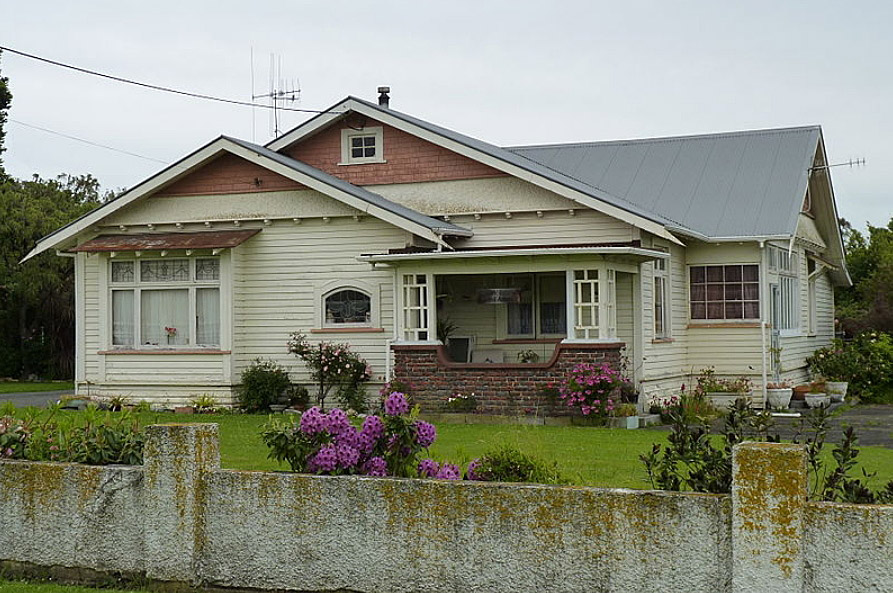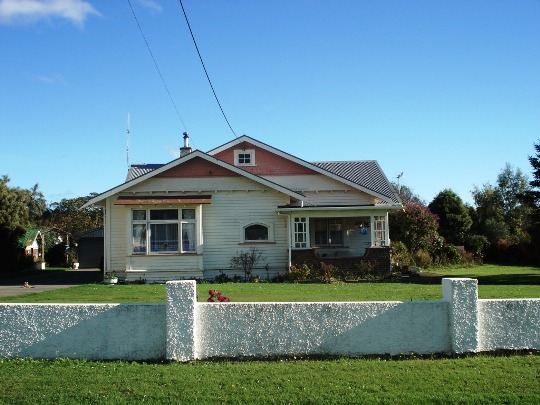The house at 64 Stout Street in Shannon is a particularly handsome bungalow, a residential form near the apex of its popularity when the house was constructed circa 1925. With a complicated assemblage of low-pitched gable roofs, broad eaves, window projections, a front porch, and simplified decorative elements, the house has architectural and aesthetic significance as an able demonstration of the way that the California bungalow heavily influenced New Zealand’s domestic design in the 1910s and 1920s. Shannon was one of a string of towns founded along the Wellington and Manawatu Railway line, which was completed in 1886. The first land sales occurred in Shannon the following year and the town experienced steady growth based in farming, flax milling, and the construction of the nearby Mangahao power scheme. Claud Hamilton Speirs was among those enjoying this prosperity. His father had been a well-known Foxton builder who expanded his interests into flax and timber. He initially worked in the building trades with his father, but by 1916 Speirs was operating his own flax mill in Shannon and, despite regular fires, his business seems to have thrived. In August 1925, Speirs married Emily Alice King and, around that time, they had an expansive, modish bungalow constructed for them. It is thought to have been designed by L.G. West & Son of Palmerston North and was likely not, despite his background, constructed by the owner. The California bungalow arrived in New Zealand via plan books and periodicals and, adapted to local conditions, it wholly displaced the once universal villa as the quintessential housing form. The bungalow became so widespread by the mid-1920s that an architect grumpily observed: ‘ ‘Bungalows! …. Nowadays anything is a bungalow.’ ’ The Speirs’ three-bedroom house is an example of bungalow architecture reaching its full potential. It had an asymmetrical, yet balanced form with multiple low-pitched gable roofs with deep eaves, robust projecting windows, and a particularly delightful front porch featuring a clinker brick balustrade and geometric corner posts. On the bungalow’s interior, the ‘simple but authoritative regime of the central hall,’ which uncompromisingly delineated and isolated rooms in a villa, morphed into a more compact space with greater functionality and a more informal character. No longer arrow-straight in most cases, the hall’s shape was malleable and utilised design features to better screen the bathroom and service areas from the principal entrance. Bungalow planning also showed increased attention given to better relating rooms within groups such as daytime/public rooms (living, dining, kitchen) and nighttime/private rooms (bedrooms). Claud Speirs lived in the bungalow until 1972; his wife had died earlier. From the exterior, it appears to remain in very good condition. What looks to have been a sleeping or sun porch on the northwest side may have had alterations to the sash and a double garage has been added as a separate outbuilding behind the house.


Location
List Entry Information
Overview
Detailed List Entry
Status
Listed
List Entry Status
Historic Place Category 2
Access
Private/No Public Access
List Number
4062
Date Entered
9th September 1985
Date of Effect
9th September 1985
City/District Council
Horowhenua District
Region
Horizons (Manawatū-Whanganui) Region
Extent of List Entry
Extent includes the land described as Pt Lots 144-145 DP 369 (RT WN321/42), Wellington Land District, and the building known as House thereon.
Legal description
Pt Lots 144-145 DP 369 (RT WN321/42), Wellington Land District
Stay up to date with Heritage this month
